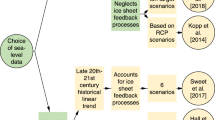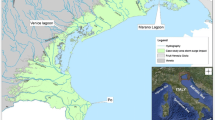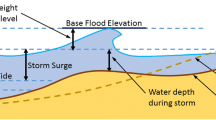Abstract
Sea level rise threatens to increase the impacts of future storms and hurricanes on coastal communities. However, many coastal hazard mitigation plans do not consider sea level rise when assessing storm surge risk. Here we apply a GIS-based approach to quantify potential changes in storm surge risk due to sea level rise on Long Island, New York. We demonstrate a method for combining hazard exposure and community vulnerability to spatially characterize risk for both present and future sea level conditions using commonly available national data sets. Our results show that sea level rise will likely increase risk in many coastal areas and will potentially create risk where it was not before. We find that even modest and probable sea level rise (.5 m by 2080) vastly increases the numbers of people (47% increase) and property loss (73% increase) impacted by storm surge. In addition, the resulting maps of hazard exposure and community vulnerability provide a clear and useful example of the visual representation of the spatial distribution of the components of risk that can be helpful for developing targeted hazard mitigation and climate change adaptation strategies. Our results suggest that coastal agencies tasked with managing storm surge risk must consider the effects of sea level rise if they are to ensure safe and sustainable coastal communities in the future.








Similar content being viewed by others
References
Adger WN (2006) Vulnerability. Glob Environ Change 16(3):268–281. doi:10.1016/j.gloenvcha.2006.02.006
Batten BK, Weberg P, Mampara, Xu L (2008) Evaluation of sea level rise for FEMA Flood Insurance Studies: magnitude and time-frames of relevance. American society of civil engineers conference proceedings. doi:10.1061/40968(312)6
Berke PR, Campanella TJ (2006) Planning for post disaster resiliency. Annal Am Acad 604:192–207
Burby RJ (2006) Hurricane Katrina and the paradoxes of government disaster policy: bringing about wise governmental decisions for hazardous areas. Annal Am Acad 60:171–191
Chrichton D (1999) The risk triangle. In: Ingleton J (ed) Natural disaster management. Tudor Rose, London, pp 102–103
Cronin S, Petterson M, Taylor P, Biliki R (2004) Maximising multi-stakeholder participation in government and community volcanic hazard management programs; a case study from Savo, Solomon Islands. Nat Hazard 33(1):105–136. doi:10.1023/b:nhaz.0000035021.09838.27
Cutter SL, Emrich CT (2006) Moral hazard, social catastrophe: the changing face of vulnerability along the hurricane coasts. Annal Am Acad Polit Soc Sci 604:102–112 (Shelter from the storm: repairing the national emergency management system after Hurricane Katrina)
Cutter SL, Boruff BJ, Shirley WL (2003) Social vulnerability to environmental hazards. Soc Sci Quart 84(2):242–261. doi:10.1111/1540-6237.8402002
Flax LK, Jackson RW, Stein DN (2002) Community vulnerability assessment tool methodology. Nat Hazard Rev 3(4):163–176. doi:10.1061/(asce)1527-6988(2002)3:4(163)
Frazier TG, Wood N, Yarnal B, Bauer DH (2010) Influence of potential sea level rise on societal vulnerability to hurricane storm-surge hazards, Sarasota County, Florida. Appl Geogr (In Press, Corrected Proof). doi:10.1016/j.apgeog.2010.05.005
Gesch DB (2009) Analysis of lidar elevation data for improved identification and delineation of lands vulnerable to sea-level rise. J Coast Res 49–58. doi:10.2112/SI53-006.1
Gesch DB, Gutierrez BT, Gill SK (2009) Coastal elevations. In: Titus JG, Anderson KE, Cahoon DR et al (eds) Coastal sensitivity to sea-level rise: a focus on the mid-atlantic region. A report by the U.S. climate change science program and the subcommittee on global change research. U.S. Environmental Protection Agency, Washington, pp 25–42
Granger K (2003) Quantifying storm tide risk in cairns. Nat Hazard 30(2):165–185. doi:10.1023/a:1026166300914
Grinsted A, Moore J, Jevrejeva S (2010) Reconstructing sea level from paleo and projected temperatures 200–2100 Clim Dynam 34(4):461–472. doi:10.1007/s00382-008-0507-2
Hallegatte S, Ranger N, Mestre O, Dumas P, Corfee-Morlot J, Herweijer C, Wood R (2011) Assessing climate change impacts, sea level rise and storm surge risk in port cities: a case study on Copenhagen. Clim Change 104(1):113–137. doi:10.1007/s10584-010-9978-3
Jackson KT (1985) Crabgrass frontier: the suburbanization of the United States. Oxford University Press, Oxford
Jelesnianski CP, Shaffer JWA (1992) SLOSH (sea, lake, and overland surges from Hurricanes). NOAA Technical Report, National Weather Service, p 48
Kleinosky L, Yarnal B, Fisher A (2007) Vulnerability of Hampton Roads, Virginia to storm-surge flooding and sea-level rise. Nat Hazards 40(1):43–70. doi:10.1007/s11069-006-0004-z
Knutson TR, McBride JL, Chan J, Emanuel K, Holland G, Landsea C, Held I, Kossin JP, Srivastava AK, Sugi M (2010) Tropical cyclones and climate change. Nat Geosci 3(3):157–163. http://www.nature.com/ngeo/journal/v3/n3/suppinfo/ngeo779_S1.html
Longshore D (2008) Encyclopedia of hurricanes, typhoons, and cyclones. Infobase Publishing, New York
Mennis J, Hultgren T (2006) Intelligent dasymetric mapping and its application to areal interpolation. Cartogr Geogr Inf Sci 33(3):179
Mercado A (1994) On the use of NOAA’s storm surge model, SLOSH, in managing coastal hazards—the experience in Puerto Rico. Nat Hazard 10(3):235–246. doi:10.1007/bf00596144
Moser SC (2005) Impact assessments and policy responses to sea-level raise in three US states: an exploration of human-dimension uncertainties. Glob Environ Change Part A 15(4):353–369. doi:10.1016/j.gloenvcha.2005.08.002
Nicholls RJ, Cazenave A (2010) Sea-level rise and its impact on coastal zones. Science 328(5985):1517–1520. doi:10.1126/science.1185782
Nicholls RJ, Wong PP, Burkett V, Codignotto J, Hay J, McLean R, Ragoonaden S, Woodroffe CD, Abuodha PAO, Arblaster J, Brown B, Forbes D, Hall J, Kovats S, Lowe J, McInnes K, Moser S, Rupp-Armstrong S, Saito Y (2007) Coastal systems and low-lying areas. In: Parry OFC ML, Palutikof JP, van der Linden PJ, Hanson CE (eds) Climate change 2007: impacts, adaptation and vulnerability. contribution of working group II to the fourth assessment report of the intergovernmental panel on climate change. Cambridge University Press, Cambridge, pp 315–356
Nicholls RJ, Marinova N, Lowe JA, Brown S, Vellinga P, de Gusmão D, Hinkel J, Tol RSJ (2011) Sea-level rise and its possible impacts given a ‘beyond 4°C world’ in the twenty-first century. Philos Trans R Soc A Math Phys Eng Sci 369(1934):161–181. doi:10.1098/rsta.2010.0291
NPCC (2009) Climate risk information. New York City Panel on Climate Change, New York
Pielke RA, Landsea CW (1998) Normalized Hurricane damages in the United States: 1925–1995. Weather Forecast 13(3):621–631. doi:10.1175/1520-0434(1998)013<0621:nhditu>2.0.co;2
Poulter B, Halpin PN (2008) Raster modelling of coastal flooding from sea-level rise. Int J Geogr Inf Sci 22(2):167–182. doi:10.1080/13658810701371858
Rahmstorf S (2007) A semi-empirical approach to projecting future sea-level rise. Science 315(5810):368–370. doi:10.1126/science.1135456
Sleeter R (2008) A new method for mapping population distribution. U.S.G.S., U.S. Geological Survey Fact Sheet 2008–3010, p 2
Thomalla F, Downing T, Spanger-Siegfried E, Han G, Rockström J (2006) Reducing hazard vulnerability: towards a common approach between disaster risk reduction and climate adaptation. Disasters 30(1):39–48. doi:10.1111/j.1467-9523.2006.00305.x
Titus JG, Hudgens DE, Trescott DL, Craghan M, Nuckols WH, Hershner CH, Kassakian JM, Linn CJ, Merritt PG, McCue TM, O’Connell JF, Tanski J, Wang J (2009) State and local governments plan for development of most land vulnerable to rising sea level along the US Atlantic coast. Environ Res Lett 4(4):044008
Vermeer M, Rahmstorf S (2009) Global sea level linked to global temperature. Proc Natl Acad Sci 106(51):21527–21532. doi:10.1073/pnas.0907765106
Wu SY, Yarnal B, Fisher A (2002) Vulnerability of coastal communities to sealevel rise: a case study of Cape May County, New Jersey, USA. Clim Res 22(3):255
Zhang K (2011) Analysis of non-linear inundation from sea-level rise using LIDAR data: a case study for South Florida. Clim Change 106(4):537–565. doi:10.1007/s10584-010-9987-2
Acknowledgments
We thank Columbia University Center for Climate Systems Research (CCSR) for the provision of data sets. This work was supported by the David and Lucile Packard Foundation and The Nature Conservancy.
Author information
Authors and Affiliations
Corresponding author
Rights and permissions
About this article
Cite this article
Shepard, C.C., Agostini, V.N., Gilmer, B. et al. Assessing future risk: quantifying the effects of sea level rise on storm surge risk for the southern shores of Long Island, New York. Nat Hazards 60, 727–745 (2012). https://doi.org/10.1007/s11069-011-0046-8
Received:
Accepted:
Published:
Issue Date:
DOI: https://doi.org/10.1007/s11069-011-0046-8




